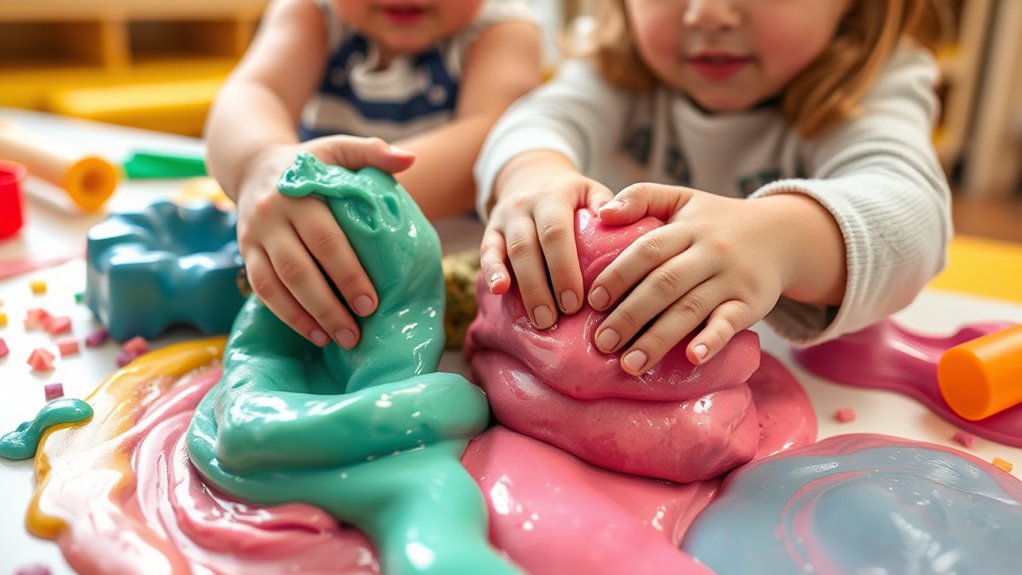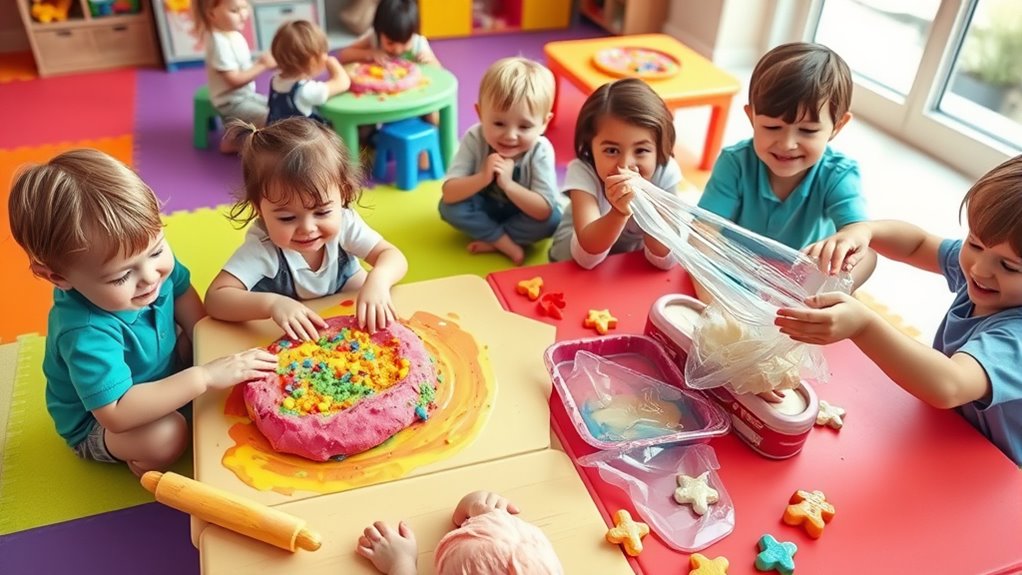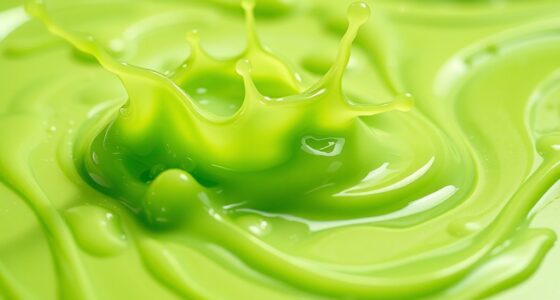Preschool sensory play, from making playdough to exploring slime science, helps your child develop essential skills like fine motor control, problem-solving, and emotional regulation. Engaging in these activities encourages curiosity, creativity, and independence while promoting language development and emotional balance. Incorporating different textures, colors, and scents keeps the experiences fun and educational. If you’d like to discover more ideas and tips to enhance your child’s sensory adventures, keep exploring!
Key Takeaways
- Sensory play activities like playdough and slime enhance fine motor skills, problem-solving, and creativity in preschoolers.
- Incorporating scents and textures into slime and playdough stimulates multiple senses for richer learning experiences.
- Mixing colors and adding objects to slime encourages visual and tactile exploration, promoting curiosity and discovery.
- Sensory activities foster social skills such as sharing, cooperation, and communication among preschool children.
- Using simple, safe materials for sensory play supports independence, emotional regulation, and overall developmental growth.

Sensory play is a critical part of preschool development because it helps young children explore their environment and build essential skills. When you introduce activities like playdough or slime, you provide opportunities for children to engage their senses in fun and meaningful ways. The beneficial benefits of sensory play extend beyond simple enjoyment; it enhances fine motor skills, encourages problem-solving, and fosters emotional regulation. As you plan activities, consider creative ideas that stimulate curiosity and creativity. For example, mixing colors into playdough or creating different textures with slime can make the experience more engaging and educational. These activities help children develop hand-eye coordination and strengthen their grasp and control, which are indispensable for writing and other school tasks. Additionally, sensory play supports language development, as children describe what they feel, see, and hear during the process, expanding their vocabulary. Incorporating a variety of textures and materials keeps sensory play exciting and offers new learning opportunities. You might try adding scents to playdough with essential oils or incorporating tiny objects into slime to challenge children to identify different items by touch. These creative ideas not only make activities more fun but also encourage children to think critically and experiment. Sensory play is also a fantastic way to help children manage emotions, especially when they’re feeling overwhelmed or anxious. The calming nature of kneading dough or squishing slime can serve as a soothing activity, providing comfort and stability. Recognizing the importance of sensory development can help caregivers select appropriate materials and activities that support overall growth. As you facilitate these activities, remind children to explore at their own pace, fostering independence and confidence. Another beneficial aspect of sensory activities is their ability to promote social skills. Children often work together to create or share their sensory experiences, learning to communicate, collaborate, and take turns. This social interaction is essential for preschoolers, helping them build relationships and develop empathy. When you introduce sensory play with materials like playdough or slime, you’re not just providing a fun activity—you’re supporting a wide array of developmental domains. The key is to keep the activities safe, accessible, and adaptable to each child’s needs. With a little creativity and preparation, you can turn simple materials into powerful tools that nurture your child’s growth, curiosity, and love for learning.
Frequently Asked Questions
What Are the Safest Ingredients for Homemade Slime?
You should use non-toxic ingredients for homemade slime to guarantee safety. Opt for allergy-safe recipes that include items like cornstarch, baking soda, and contact lens solution with boric acid. Avoid harsh chemicals like borax or dyes that might cause allergies. Always check ingredient labels and test small amounts first. By choosing non-toxic, allergy-safe ingredients, you create a fun, safe sensory experience for your preschoolers.
How Does Sensory Play Support Emotional Development?
Think of sensory play as a calming river that guides your child’s emotional growth. You help them practice emotional regulation and find stress relief through hands-on activities like slime and playdough. These experiences allow kids to express feelings, soothe anxiety, and build resilience. As they explore textures and shapes, they learn to manage emotions better, creating a safe space for emotional development and nurturing their overall well-being.
Can Sensory Activities Improve Fine Motor Skills?
Yes, sensory activities can improve your child’s fine motor skills by enhancing sensory integration and motor coordination. When kids manipulate playdough, slime, or other textured materials, they strengthen small muscles in their hands and fingers. These activities promote precision and control, which are essential for tasks like writing and buttoning clothes. Engaging in sensory play regularly helps your child develop better motor skills, supporting their overall growth and independence.
What Are Age-Appropriate Sensory Toys for Toddlers?
Think of it as planting seeds for curiosity; age-appropriate sensory toys for toddlers include soft silicone teething rings, textured balls, and squishy sensory mats. These toys promote sensory play benefits like improved focus and motor skills. Always prioritize toddler toy safety by choosing non-toxic, sturdy options. Your little one will explore safely, building confidence and sensory awareness while you watch them grow and learn through play.
How to Prevent Allergies During Sensory Play?
To prevent allergies during sensory play, prioritize allergy awareness by asking parents about any known allergies. Use safe ingredient selection by choosing non-toxic, hypoallergenic materials like gluten-free flour or allergy-friendly dyes. Always supervise closely and introduce new ingredients gradually. Keep a clean workspace, and have allergy-safe alternatives ready. This proactive approach minimizes allergy risks, ensuring a fun, safe sensory experience for every child.
Conclusion
So, while you might think sensory play is just about squishing and squeezing, it actually unleashes a world of learning your little one might never notice. Ironically, the messiest activities—like slime and playdough—are often the most educational. So next time you’re cleaning up, remember: it’s not just chaos; it’s discovery in disguise. Who knew that a little goo could be the key to big brain gains?










